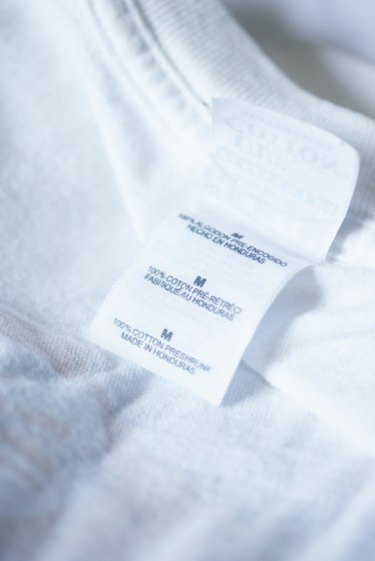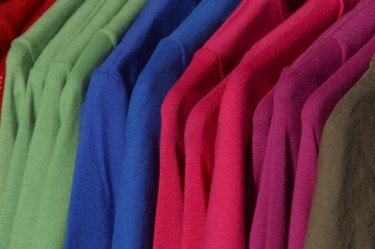
When you conjure up an image of a tie-dyed shirt in your mind's eye, you most often think of a simple cotton tee shirt. But there's no need to limit your fashion choices. And you don't have to throw out your favorite shirt just because it looks old and faded. Once you know the best shirts that accept dyes, your fashion horizons expand well beyond the typical and you can easily transfuse a tired shirt with new life.
Fabric Choice
Video of the Day

The best shirts to tie dye are made of natural fibers, such as cotton, hemp, linen, ramie (also known as rayon), silk and wool. Natural fibers are hydrophilic, meaning they absorb water and easily accept an array of dye types and colors. Avoid choosing synthetic fabrics such as acetate, acrylic or polyester, because their hydrophobic fibers repel water, making them hard to dye.
Video of the Day
Shirt Choice

Choose a shirt without a print, as even a small print may interfere with the tie-dye design. Choose white or a solid color fabric that coordinates with the dye colors. Choose a shirt with little embellishment, as it may interfere with or become damaged in the pre-treating and/or dyeing processes. Choose a loosely-woven fabric to prevent the wicking (absorption) of dye into adjacent fibers.
Dye Choice

There are many types of dye to choose from and each fabric accepts a certain dye better than another. For example, wool readily accepts most natural, protein-based dyes whereas cotton requires a fiber-reactive dye that contains acid. There are also many dyeing processes to choose from; some dyes need hot water to dissolve and react. Therefore, use the proper dye for your specific fabric and have the proper equipment needed to accomplish the task.
Fabric Treatments

Some fabrics have undergone treatments after they have been woven so that they retain certain characteristics like stiffness. Other fabrics have a natural substance that should be removed prior to dyeing. For example, silk contains a gummy substance called sericin, and cotton contains natural waxes and other impurities that should be removed prior to dyeing. Thoroughly clean the garment before dyeing to ensure any substances that could repel the dye are eliminated.
Things to Consider

If the shirt to be dyed has a zipper, be aware a metal zipper may rust in an acid-based dye. The zipper color will likely not change after dyeing because zippers are most often synthetic. If a shirt has buttons, close the buttons before the dyeing process to ensure a uniform pattern. Be aware that the color of the buttons will likely remain unchanged after dyeing, unless made of a natural substance like wood.